previous | contents | next
Estimates of Households and Dwellings in Scotland, 2011
2. Results
2.1 Number of households and dwellings
Table 1 shows the number of households in each local authority in Scotland from 1991 to 2011 and Table 2 shows the number of dwellings from 2001 to 2011. Figure 1 shows the annual change in the number of households from 2001 to 2011 and Figure 2 shows the percentage change in the number of households between 2001 and 2011 in each local authority in Scotland.
A 'dwelling' refers to the accommodation itself, for example a house or a flat. A 'household' refers to the people living together in that dwelling. The number of households will be smaller than the number of dwellings, as some dwellings are vacant or second homes. Some further adjustments are made to the figures on households - Section 3 gives more information and definitions.
These tables and figures show the following trends:
- In mid-2011, there were 2.37 million households in Scotland - an increase of around 173,000 (7.9 per cent) over the past ten years.
- The number of households in Scotland has increased every year for the last ten years. However, the rate of increase has slowed substantially since the start of the economic downturn. The rate of growth slowed rapidly in the two years since 2007, and less so in the following two years. Between 2010 and 2011 the number of households increased by 10,600, a rise of 0.5 per cent. This is the lowest yearly increase in the last ten years.
- The rate of growth in households has been affected by falls in new housing supply in Scotland. New housing supply (which includes new builds, refurbishments and conversions) has fallen in each year from 2008-09 to 2010-11, from around 27,600 units in 2007-08 to 17,100 units in 2010-11 (Footnote 7). The rate of decline has been slowing, from 19 per cent in 2008-09 to 17 per cent in 2009-10 and eight per cent in 2010-11 (Footnote7). The falls are mainly down to reductions in private sector completions. New starts were also down in 2010-11: they fell by 11 per cent (around 1,600 units) compared with 2009-10 (Footnote 7). The construction sector has been badly affected by the economic downturn which began in 200 (Footnote 8, 9 and 10). Reductions in new house building go some way to explaining the slowing of the rate of increase in household numbers since the start of the downturn. It is likely that other factors such as the constrained mortgage and labour markets are also having an effect on new household formation (Footnote 11).
- The number of households has increased since 2010 in every local authority except Clackmannanshire (a fall of 5 households), Inverclyde (a fall of 70 households) and West Dunbartonshire (a fall of 20 households). Over the past ten years there has been an increase in the number of households in all areas apart from Inverclyde (where the number of households fell by 0.7 per cent, 267 households). The area with the greatest increase since 2001 in percentage terms has been Aberdeenshire (an increase of 15.2 per cent, 13,800 households) though Edinburgh City has seen the largest absolute increase (17,000 households, an increase of 8.3 per cent).
- The total number of dwellings shows a very similar trend to the total number of households. In September 2011 there were 2.50 million dwellings in Scotland, an increase of 0.5 per cent or 12,400 dwellings since 2010. This is slightly higher than the increase seen between 2009 and 2010 (by 14 dwellings) but still considerably lower than the annual increases in earlier years (the number of dwellings in Scotland has increased by an average of around 18,000 a year since 2001).
- All local authorities saw an increase in the number of dwellings between 2010 and 2011 except Dundee City where the number of dwellings fell by 486 (or 0.7 per cent). Dundee City has carried out large scale demolitions of tower blocks in the Hilltown and Menzieshill areas over the second half of 2010 and 2011. The majority of these dwellings were lying vacant in 2010 therefore the reduction in the number of dwellings is not associated with a reduction in the number of households in Dundee City.
Figure 1: Annual increase in the number of households in Scotland between 2001 and 2011 (Chart)
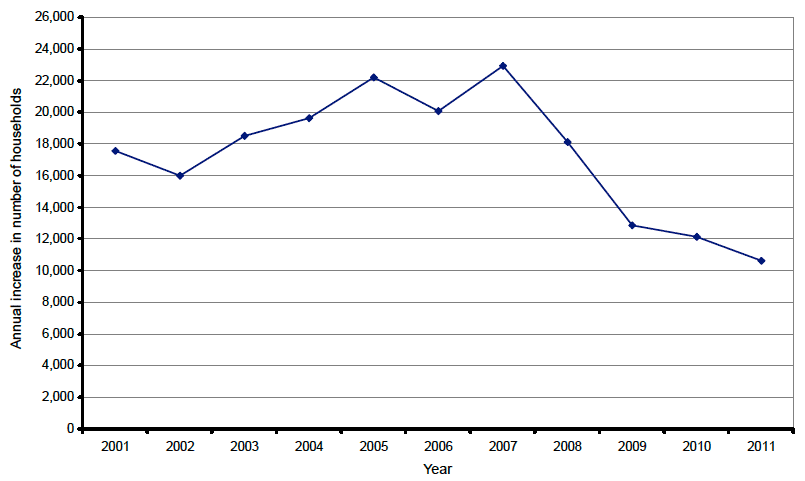
Figure 2: Percentage change in the number of households 2001-2011 by local authority (Chart)
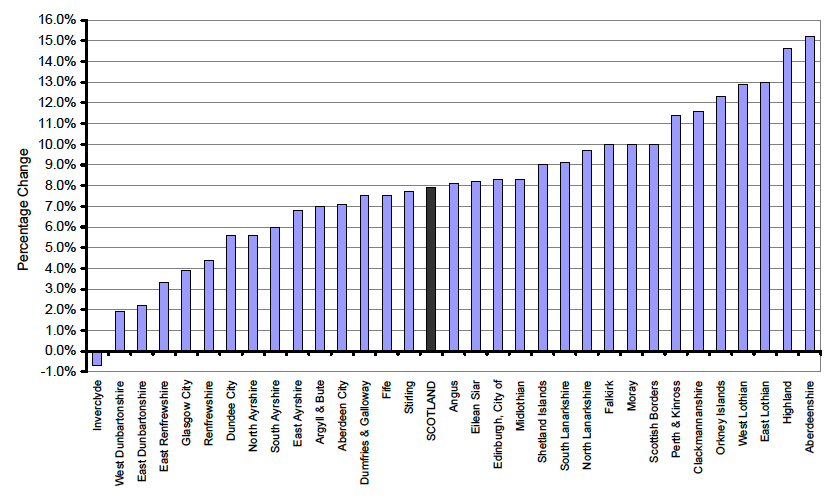
2.2 Characteristics of dwellings
Tables 3 to 6 show the number of dwellings by Council Tax band, type of dwelling (flat, terraced, semi-detached or detached), number of rooms per dwelling and density of housing. Information on the definitions of these dwelling characteristics is given in Section 3.2.
These figures are summarised by urban-rural classification in Table 3 (according to the Scottish Government 6-fold urban-rural classification), by level of deprivation in Table 4 (according to the Scottish Index of Multiple Deprivation) and by local authority in Table 5. Strategic Development Plan (SDP) areas are planning authorities which cover the four largest city regions around Aberdeen, Dundee, Edinburgh and Glasgow. Summary information is available for each SDP area and for Scotland's two National Parks in Table 6. Background information on the Scottish Government Urban Rural Classification and the Scottish Index of Multiple Deprivation is given in Sections 3.4 and 3.5.
A description of the SDP areas and National Parks areas is given in Section 3.6. Background information on the population by age group is included in Tables 3, 4 and 6.
These tables highlight the following trends:
Council Tax Band
- The proportion of dwellings in the lower value Council Tax bands (bands A-C) varies across the country. Accessible rural areas have the smallest proportion of dwellings in the lower value Council Tax bands (46 per cent compared to 62 per cent for Scotland as a whole), and the highest proportion of dwellings in the higher Council Tax bands: 23 per cent of dwellings in these areas are in Council Tax bands F to H compared with a Scottish average of 12 per cent.
- The proportion of dwellings in the lower value Council Tax bands increases with the level of deprivation of the area. In the most deprived areas almost all dwellings (95 per cent) are in the lower value Council Tax bands, compared to just 13 per cent in the least deprived areas.
- Eilean Siar is the local authority with the highest percentage of dwellings in lower value Council Tax bands (79 per cent) and East Renfrewshire has the lowest percentage of dwellings in these bands (28 per cent).
- Of the four SDP areas, Glasgow and the Clyde Valley has the highest proportion of dwellings in lower value Council Tax bands (65 per cent) and the lowest proportion of dwellings in the highest value Council Tax bands (i.e. bands F-H): 10 per cent.
- In the Cairngorms National Park 46 per cent of dwellings are in Council Tax bands A-C and in Loch Lomond and the Trossachs National Park, the figure is 35 per cent. This is substantially lower than the figure for Scotland, which is 62 per cent.
- It is important for the interpretation of these statistics to note that the Council Tax band reflects the Assessor's opinion of open market value, subject to a number of statutory assumptions. Assessors base their opinion of value on the actual selling prices of similar properties which sold around the valuation date of 1 April 1991. More information about this can be found on the Scottish Assessors Association website.
Types of property
- Figure 3 and Figure 4 show that there are higher proportions of flats in urban areas and in more deprived areas. In contrast, there are higher proportions of detached houses in rural areas and in less deprived areas.
- The three island authority areas (Eilean Siar, Orkney Islands and Shetland Islands) have the highest percentages of detached dwellings (over 58 per cent of all dwellings, compared to 21 per cent for Scotland as a whole). Almost three quarters of dwellings (73 per cent) in Glasgow City are flats compared with less than 10 per cent of dwellings in each of the three island authority areas and 38 per cent of dwellings for Scotland as a whole.
- There are higher proportions of detached properties in the Cairngorms National Park (51 per cent of all dwellings) and Loch Lomond and the Trossachs National Park (46 per cent of all dwellings), compared to 21 per cent for Scotland as a whole.
- The median number of rooms per dwelling is lower in more deprived areas. For dwellings in the 10 per cent most deprived areas, the median number of rooms is three, whereas for those in the 10 per cent least deprived areas, the median number of rooms is five. Dwellings in large urban areas have a median of three rooms whereas the median number of rooms per dwelling for all other areas is four. The number of rooms only includes habitable rooms (usually bedrooms and living rooms). Information on number of rooms may not always represent the most up to date position. Assessors are only able to reflect physical changes and alterations to dwellings once they have been sold and a reconsideration of the banding has taken place.
Figure 3: Dwelling types by urban-rural classification, 2011 (Chart)
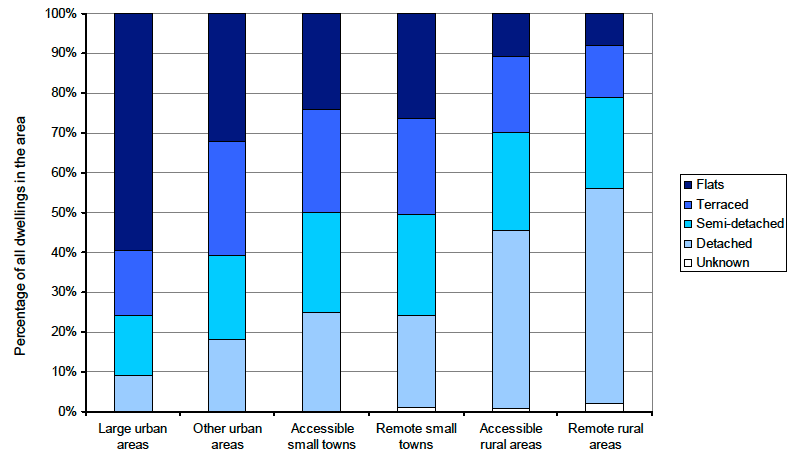
Figure 4: Dwelling types by Scottish Index of Multiple Deprivation (SIMD) decile, 2011 (Chart)
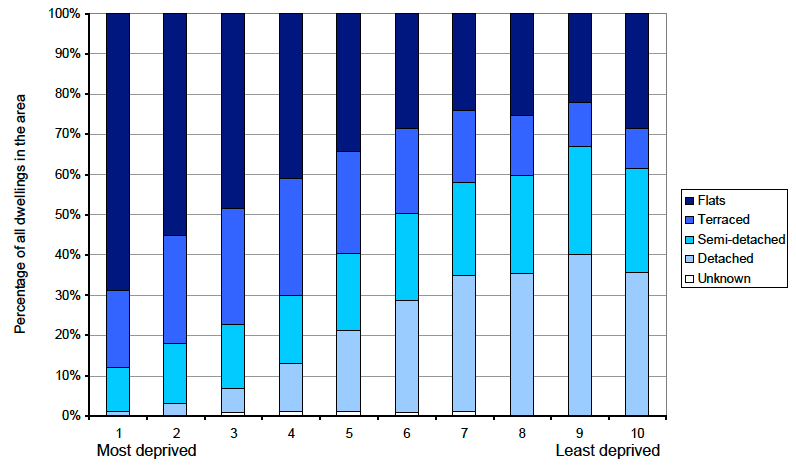
Density of housing
- The density of housing increases from an average of 0.03 dwellings per hectare in remote rural areas to an average of 10.66 dwellings per hectare in large urban areas. The figure for Scotland as a whole is 0.32 dwellings per hectare.
- In general, the density of housing increases as the level of deprivation increases, although it also increases in the least deprived areas. The most deprived areas have the highest density of housing, with an average of 15.75 dwellings per hectare. The least deprived areas (often in urban areas (Footnote 12) have a relatively high density of 5.61 dwellings per hectare.
- Glasgow City has the highest average density of housing all of local authorities (16.91 dwellings per hectare) followed by Dundee City (12.25 dwellings per hectare). Highland has the lowest density of housing, an average of 0.04 dwellings per hectare.
- Glasgow and the Clyde Valley SDP area has a higher average density of housing than the other SDP areas, with an average of 2.54 dwellings per hectare compared to between 0.28 and 0.83 dwellings per hectare for the other three areas.
- The Cairngorms National Park and Loch Lomond and the Trossachs National Park both have low average housing densities (0.02 and 0.04 dwellings per hectare respectively).
- The trends in density of housing described here are very similar to those in seen in population density.
2.3 Characteristics of households
Tables 7 to 10 show the percentage of dwellings which are occupied, vacant or second homes. They include the percentage of dwellings entitled to a Council Tax discount because they are occupied by one adult (living alone, with children, or with other adults who are 'disregarded' for Council Tax purposes). They also show the percentage of dwellings which are occupied but exempt from paying Council Tax, such as households entirely occupied by students, or armed forces accommodation.
These figures are summarised by urban-rural classification in Table 7, by level of deprivation in Table 8 and by local authority in Table 9. Summary information is available for each Strategic Development Plan (SDP) area and for Scotland's two National Parks in Table 10.
These tables highlight the following trends:
Vacant dwellings and second homes
- Across Scotland, 2.8 per cent of dwellings are vacant and 1.5 per cent are second homes, though there is wide variation across the country. Vacant dwellings will include new homes which are yet to be occupied and dwellings which are empty and awaiting demolition, amongst others.
- Remote rural areas have the lowest percentage of dwellings which are occupied (88 per cent, compared to between 95 and 97 per cent in other areas). This is because remote rural areas have relatively high percentages of vacant dwellings (4.8 per cent of all dwellings in these areas) and second homes (7.3 per cent). Around two to three per cent of dwellings are vacant in other areas and around one to two per cent are second homes. These trends are shown in Figure 5.
- Figure 6 shows that more deprived areas have the highest percentage of dwellings which are vacant (4.6 per cent in the 10 per cent most deprived areas). In other areas, the figures vary between 1.8 and 3.2 per cent, with the proportion of vacant dwellings generally being lower in less deprived areas. The higher percentage of vacant dwellings in more deprived areas may be due at least in part to regeneration activity which can result in properties lying empty as they are being refurbished or awaiting demolition.
- The proportion of second homes is lowest in the most deprived areas. It increases as the level of deprivation goes down, before falling again in the least deprived areas. This may be because the greatest concentrations of second homes are found in remote rural areas, which may not necessarily be the most or the least deprived (Footnote 13).
- The map in Figure 7 shows the percentage of dwellings in each local authority which are vacant. The percentages are highest in Eilean Siar, Inverclyde and Orkney Islands, where more than five per cent of dwellings are vacant.
- Argyll and Bute is the local authority area with the highest percentage of second homes (8.4 per cent) followed by Eilean Siar (6.4 per cent), Orkney Islands (4.5 per cent) and Highland (4.1 per cent).
- The TAYplan SDP area has the highest percentage of vacant dwellings (3.6 per cent) and second homes (2.6 per cent). In the other SDP areas, the proportion of vacant dwellings is between 2.4 and 2.8 per cent, the figure for Scotland as a whole is 2.8 per cent.
- The Cairngorms National Park has a relatively low percentage of dwellings which are occupied (83 per cent). The figure for Loch Lomond and the Trossachs National Park is 89 per cent. This is still lower than the Scottish figure of 96 per cent. The two National Parks have relatively high proportions of dwellings which are second homes - 12.5 per cent in the Cairngorms National Park and 7.1 per cent in Loch Lomond and the Trossachs National Park. The equivalent figure for Scotland is 1.5 per cent.
Figure 5: Vacant dwellings and second homes by urban-rural classification, September 2011 (Chart)
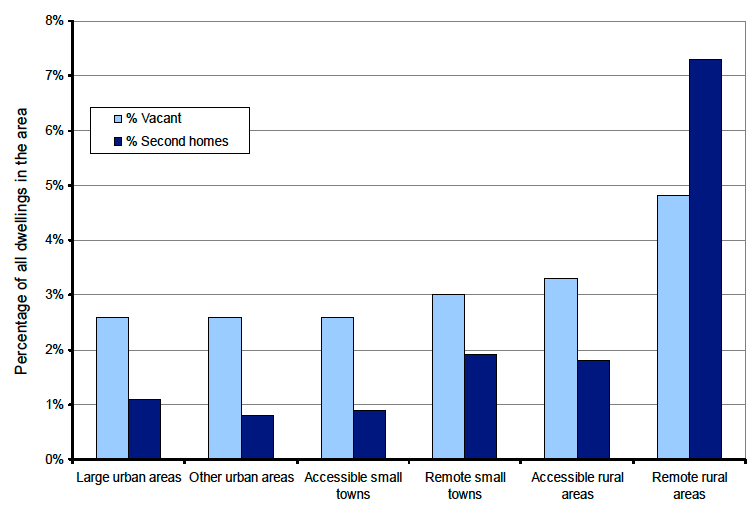
Figure 6: Vacant dwellings and second homes by Scottish Index of Multiple Deprivation (SIMD) decile, September 2011 (Chart)
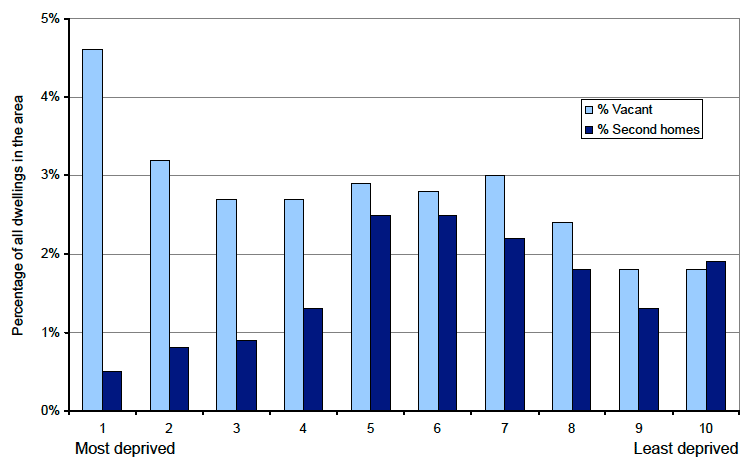
Figure 7: Percentage of dwellings which are vacant in each local authority area in Scotland, 2011 (Map)
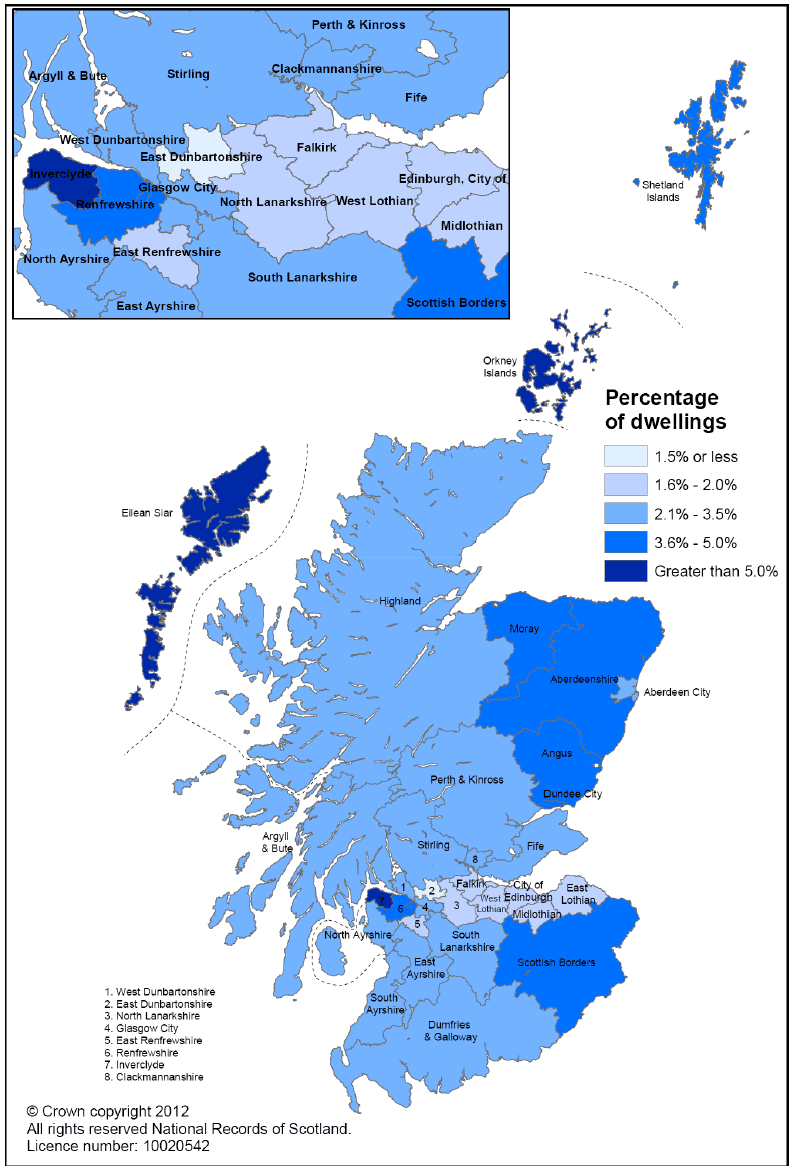
Single adult discount
- Thirty eight per cent of dwellings in Scotland are entitled to a 'single adult' Council Tax discount. This category includes one adult living alone, with children, or with other people who are 'disregarded' for Council Tax purposes. The percentage of dwellings where this discount applies varies from 29 per cent in Aberdeenshire to 47 per cent in Glasgow City.
- The proportion of dwellings entitled to a 'single adult' discount is higher in urban areas - 42 per cent in large urban areas compared to 29 per cent of all dwellings in rural areas (either accessible or remote), as Figure 8 shows. This proportion also increases steadily as the level of deprivation increases, from 28 per cent of all dwellings in the least deprived areas to 52 per cent in the most deprived areas. This is shown in Figure 9.
- In both National Park areas the proportion of dwellings which have a 'single adult' discount (29 per cent for the Cairngorms National Park and 28 per cent for Loch Lomond and the Trossachs National Park) is lower than the Scottish figure of 38 per cent.
Figure 8: Percentage of dwellings entitled to a 'single adult' discount by urban-rural classification, September 2011 (Chart)
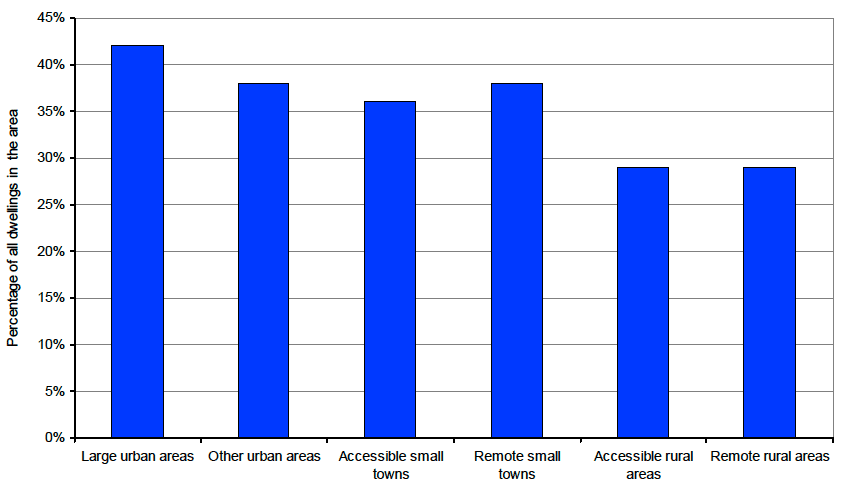
Figure 9: Percentage of dwellings entitled to a 'single adult' discount by Scottish Index of Multiple Deprivation (SIMD) decile, September 2011 (Chart)
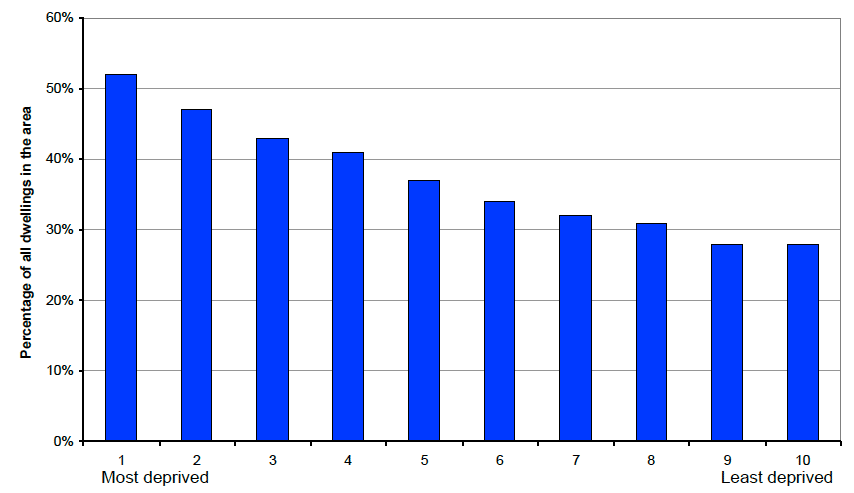
'Occupied exemptions'
- Large urban areas have the highest percentage of dwellings (4.7 per cent) which are occupied and exempt from paying Council Tax, such as all-student households and armed forces accommodation. Urban areas are more likely to have universities and a larger number of all-student households. For instance, the local authorities with the highest percentages of dwellings with 'occupied exemptions' are Dundee City (7.2 per cent), City of Edinburgh (6.6 per cent), Aberdeen City (6.6 per cent) and Glasgow City (5.0 per cent), all of which contain major universities. The national figure is 2.7 per cent. Stirling and Moray also have higher percentages of dwellings with 'occupied exemptions' than Scotland as a whole: there is a university in Stirling and two Royal Air Force bases in Moray.
- The percentage of dwellings which are occupied and exempt from paying Council Tax is between three and four per cent for Aberdeen City and Shire, TAYplan and SESplan SDP areas. The figure for Glasgow and the Clyde Valley SDP area is slightly lower (2.6 per cent of all dwellings). In both National Parks the percentage of dwellings with 'occupied exemptions' is much lower than the figure for Scotland as a whole (0.4 per cent in Cairngorms and 0.7 per cent in Loch Lomond and the Trossachs).
2.4 Variation within local authority areas
Scottish Neighbourhood Statistics and data zones
There can be a great deal of variation in household characteristics within a local authority. The Scottish Neighbourhood Statistics (SNS) website contains statistics for each 'data zone' in Scotland. Data zones are a standard geography used for a range of statistics. When first created in 2004, the average data zone was designed to contain around 750 people, which is small enough to provide quite detailed local information and can be aggregated to different areas of interest.
The information summarised in this publication is available at data zone level from the SNS website. This includes the number of dwellings by Council Tax band, type of dwelling, number of rooms per dwelling, density of housing and the percentage of dwellings which are occupied, vacant, second homes, entitled to a 'single adult' Council Tax discount, or an 'occupied exemption'. The SNS website allows users to view tables or maps for individual areas, or to download all the data in order to analyse it further.
Figures 10, 11, 12 and 13 illustrate the types of maps that can be produced to show information at data zone level.
Figure 10 shows the percentage of dwellings in each data zone which are vacant. This shows the considerable local variations in the percentages of vacant dwellings in every local authority. The map also highlights the relatively high percentage of vacant dwellings in remote rural parts of local authorities such as Highland. These cannot be identified by looking at Figure 7, which shows figures for entire local authorities.
The inset maps in Figures 7 and 10 show that, in general, there are lower percentages of vacant dwellings in much of the 'Central Belt' of Scotland. However, the data zone map (Figure 10) shows that there are still some data zones with high percentages of vacant dwellings. These might be caused by new builds, long term empty properties or by vacant properties awaiting demolition. Some data zones in urban areas which contain high concentrations of vacant dwellings may not be easily seen on a map such as Figure 10 because they have a small land area. It is possible for users to produce more focused maps using the SNS website.
Figure 11 shows the percentage of dwellings which are second homes in each data zone in Scotland. The map shows that there are wide variations in the proportions of second homes within many local authority areas, such as Highland. North Ayrshire is another example of an area with wide variation in the percentage of second homes: data zones in the mainland part of the council have relatively low percentages of second homes compared with the islands of Arran and Greater Cumbrae. There are relatively high numbers of second homes in remote rural areas.
Figure 12 shows the percentage of dwellings in each data zone which are flats. Urban areas and areas closer to the 'Central Belt' of Scotland tend to have higher proportions of flats. The inset map shows that there are local variations in the percentages of flats and these are often in town centres or in cities. In general, remote rural areas have low percentages of flats.
Figure 13 gives an illustration of a more detailed map that can be obtained from the SNS website. It shows the percentage of dwellings in Council Tax bands A to C in each data zone in Aberdeen City and some of the surrounding area. The highest proportions of such dwellings are mainly in the central areas of Aberdeen City with much lower proportions in the outer lying areas.
Figure 10: Percentage of dwellings which are vacant in each data zone in Scotland, 2011 (Map)
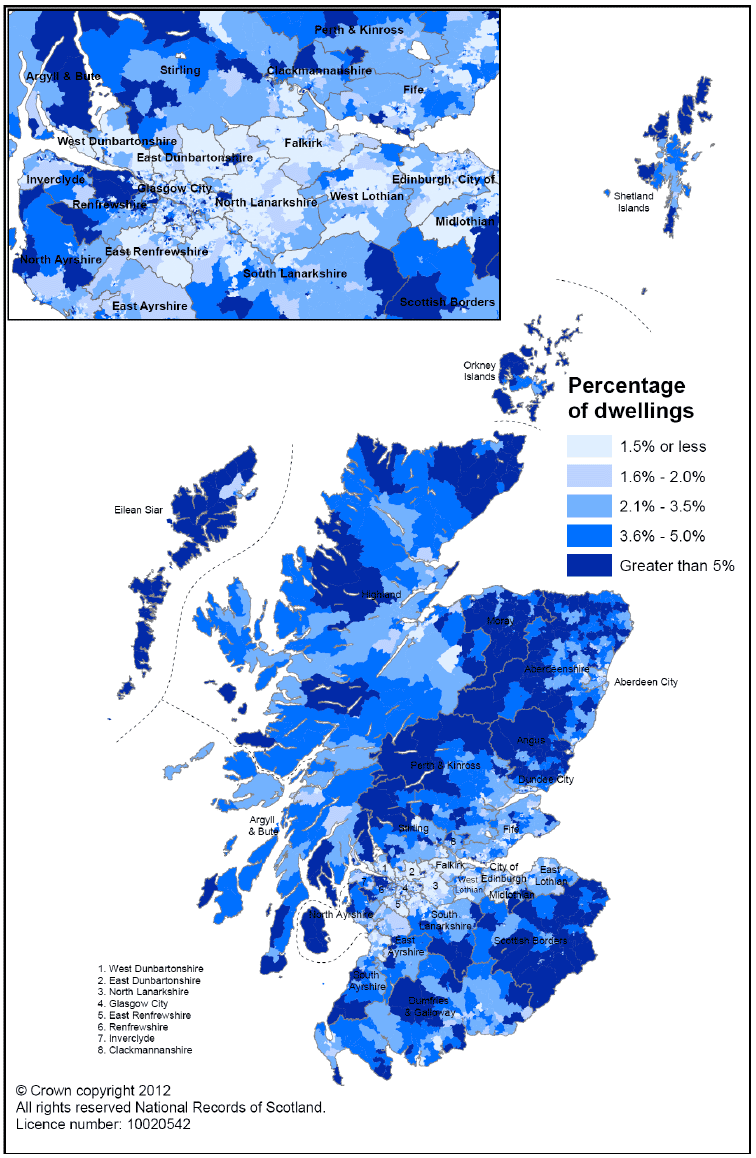
Figure 11: Percentage of dwellings which are second homes in each data zone in Scotland, 2011 (Map)
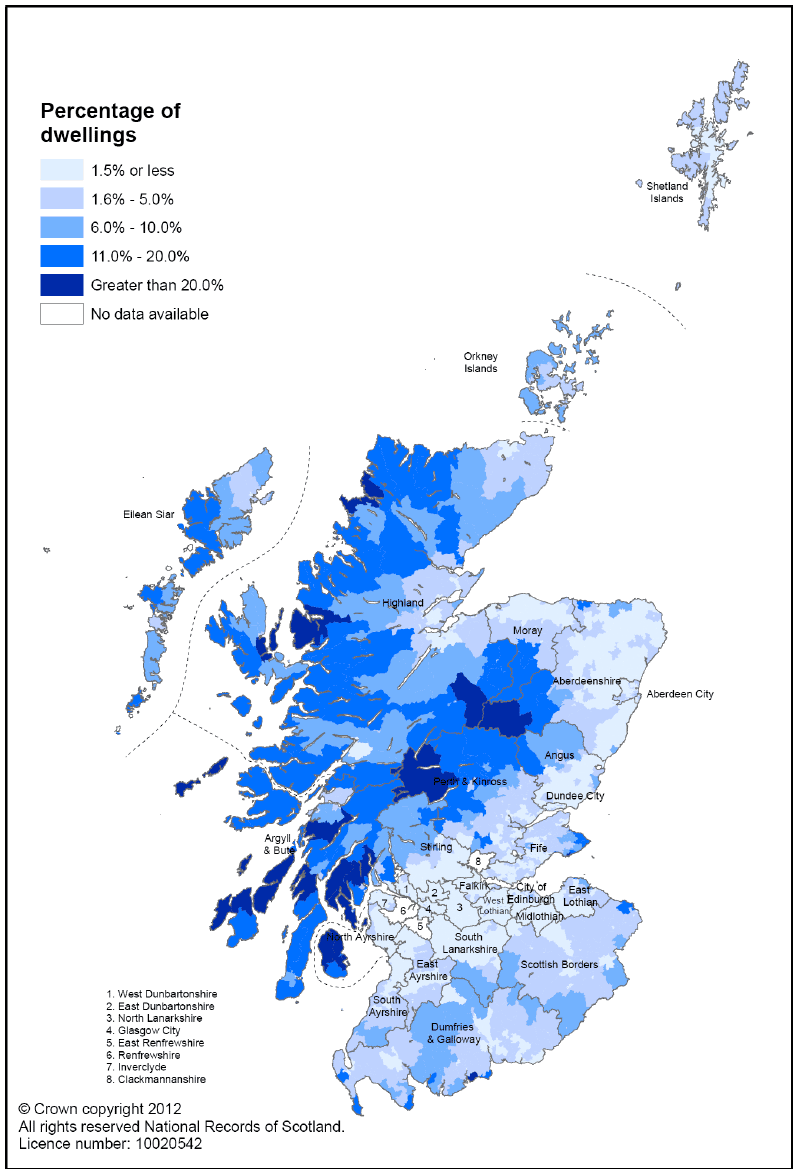
Figure 12: Percentage of dwellings which are flats in each data zone in Scotland, 2011 (Map)
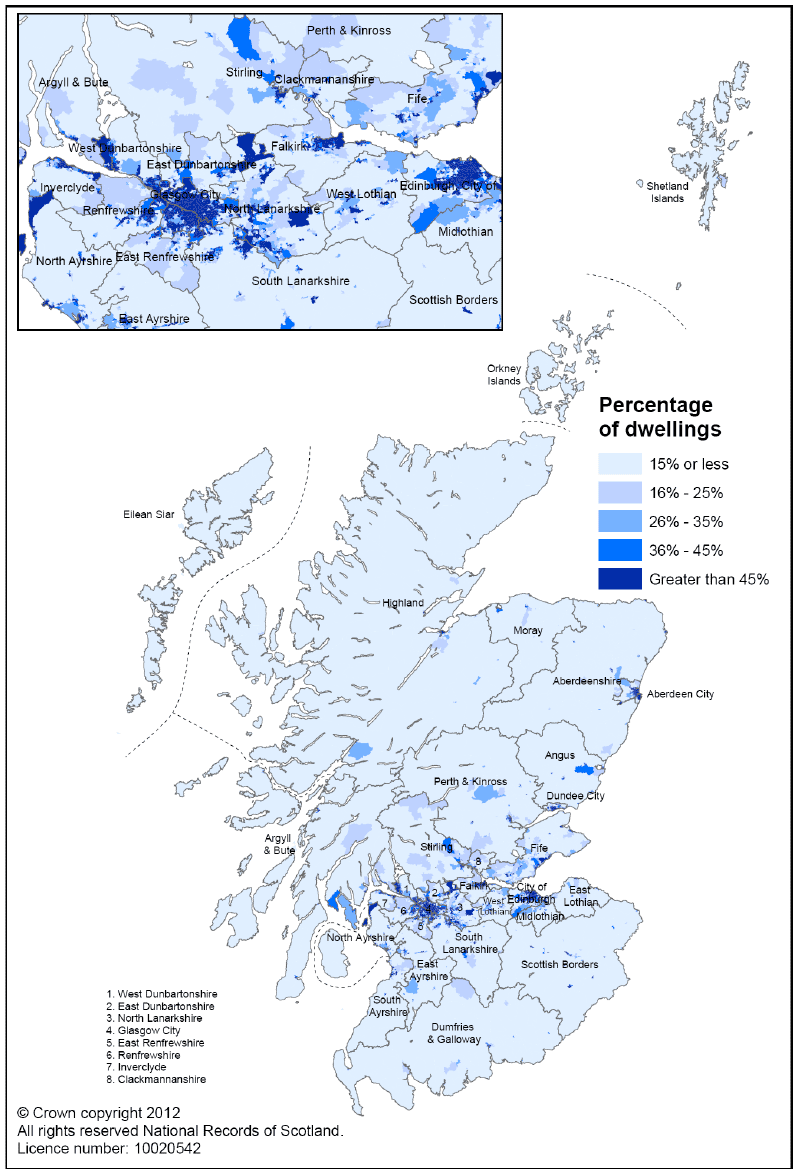
Figure 13: Percentage of dwellings in Council Tax bands A-C in each data zone in Aberdeen City, 2011 (Map)
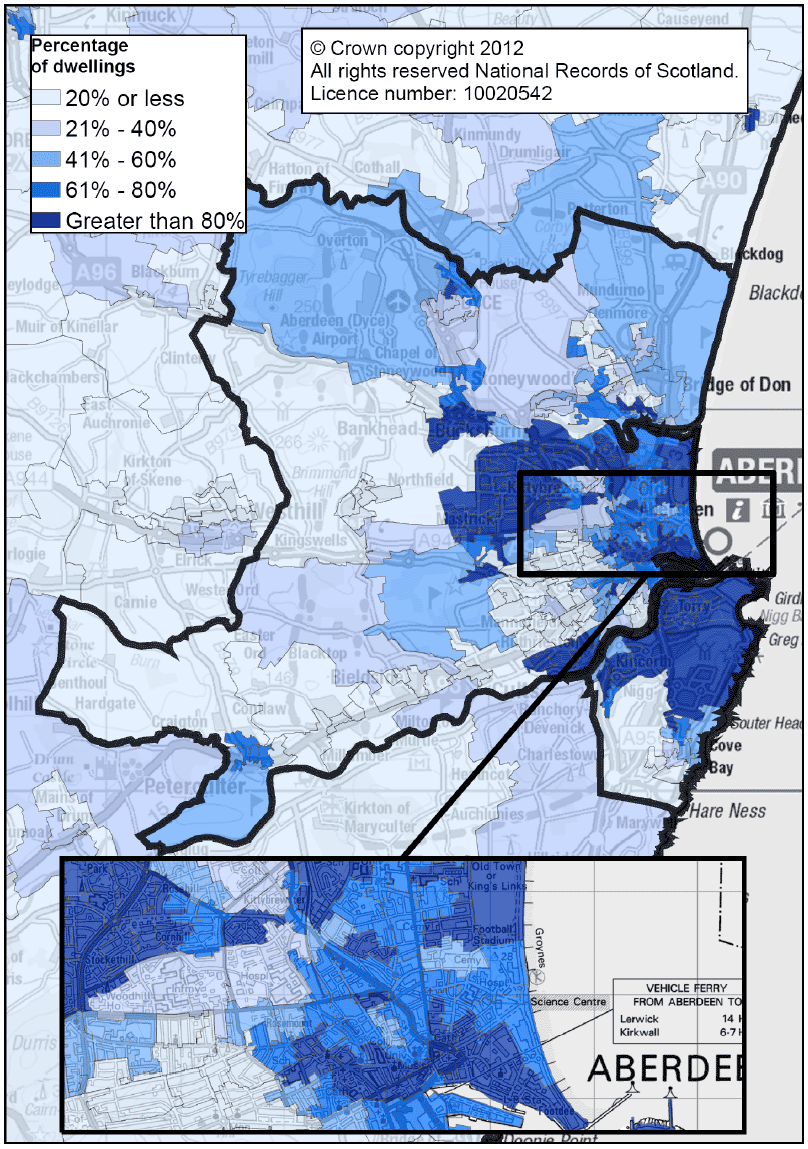
Figures 10, 11, 12 and 13 provide useful illustrations of the data, but it is not possible to include detailed data zone maps for every part of Scotland in this publication (though users can produce their own maps on the SNS website). An alternative way of illustrating the variation within a local authority is through the use of boxplots.
Figures 14, 15, 16 and 17 use boxplots to illustrate the variation within each local authority. These show the percentage of dwellings in each local authority which are vacant, are second homes, have 'single adult' discounts, or are classed as 'occupied exemptions'. Boxplots show the middle ranked data zone and they also show the level of variation - the larger the box, the more variation there is within that local authority area. An illustration of a boxplot is shown below.
Example of a box plot
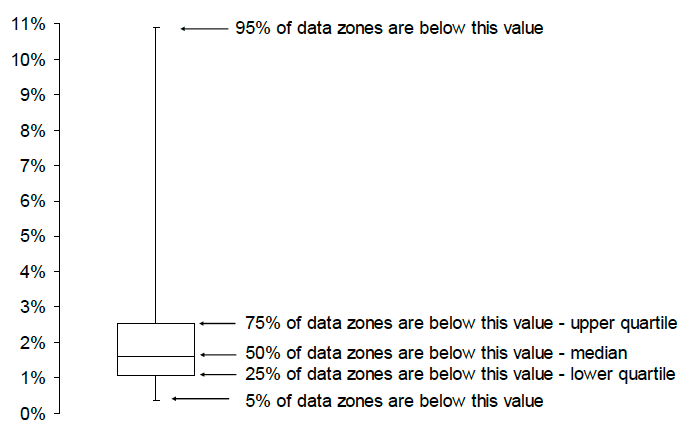
The example above shows the percentage of dwellings which are vacant in each data zone in Glasgow City (from Figure 14). This shows that in half the data zones in Glasgow City, less than two per cent of dwellings are vacant, but that the proportion varies across the local authority. In the five per cent of data zones with the lowest figures, less than 0.5 per cent of all dwellings are vacant. In the five per cent of data zones with the highest figures, more than around 11 per cent of dwellings are vacant. Various regeneration projects are taking place across Glasgow. These often involve dwellings lying vacant whilst awaiting demolition or repair work.
Figures 14, 15, 16 and 17 confirm some of the trends seen in the previous tables:
Figure 14 shows that in general, there is a higher proportion of vacant dwellings in the more rural local authorities, including the island authorities. However, there are a few data zones with particularly high numbers of vacant dwellings (where over 10 per cent of dwellings are vacant) in Inverclyde and Glasgow City. This may be related to regeneration work.
Figure 15 shows there is also generally a higher proportion of second homes in the more rural local authorities including the island authorities. In half of the data zones in Argyll and Bute less than one in 20 dwellings is a second home. However in five per cent of data zones in this local authority at least 22 per cent of dwellings are second homes.
Figure 16 shows that there tend to be more dwellings with 'single adult' discounts in the urban local authorities, though there is a lot of variation within every local authority. Glasgow City has the highest median value of 47 per cent but in the lowest five per cent of data zones less than a quarter of dwellings have a single adult discount whereas in the highest five per cent of data zones more than 65 per cent of dwellings have a single adult discount. This category includes one adult living alone, with children or with other people who are 'disregarded' for Council Tax purposes.
Figure 17 shows that most local authority areas have relatively few dwellings entitled to 'occupied exemptions'. The exceptions tend to be areas with large student populations (e.g. City of Edinburgh, Dundee City, Glasgow City, Aberdeen City and Stirling) and areas with armed forces bases (e.g. Moray, City of Edinburgh and Argyll & Bute). These areas tend to be quite concentrated - the median percentage of 'occupied exemptions' in these local authorities is less than four per cent, but they have a few data zones with far higher figures. The largest variation can be seen in Moray, where there are two Royal Air Force bases: the median is less than one per cent but in five per cent of data zones around a third of dwellings or more are entitled to occupied exemptions.
Figure 14: Percentage of dwellings in each data zone which are vacant in each local authority, September 2011 (Boxplot)
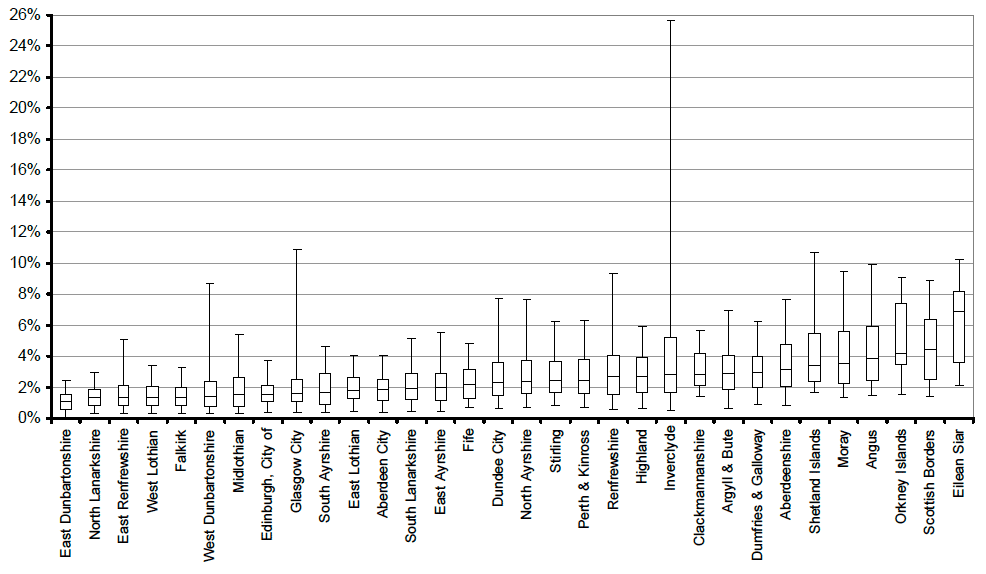
Figure 15: Percentage of dwellings in each data zone which are second homes in each local authority, September 2011 (Boxplot)
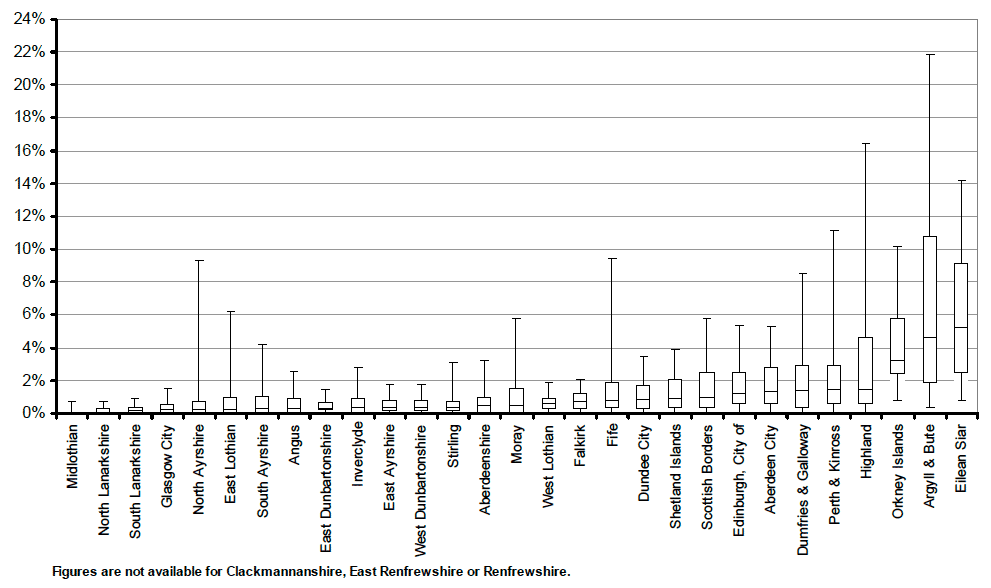
Figure 16: Percentage of dwellings in each data zone with a 'single adult' discount in each local authority, September 2011 (Boxplot)
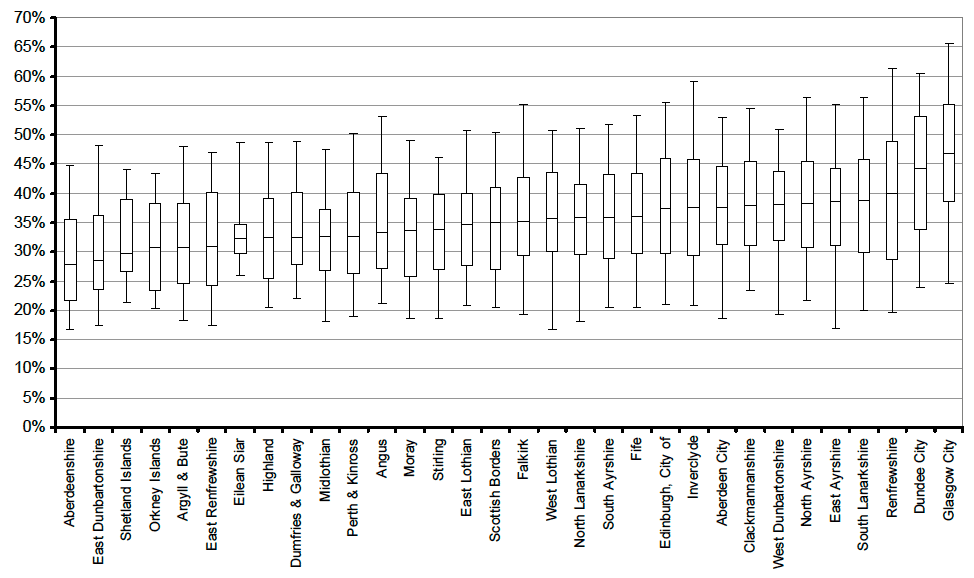
Figure 17: Percentage of dwellings in each data zone with 'occupied exemptions' (e.g. all student households or armed forces accommodation) in each local authority, September 2011 (Boxplot)
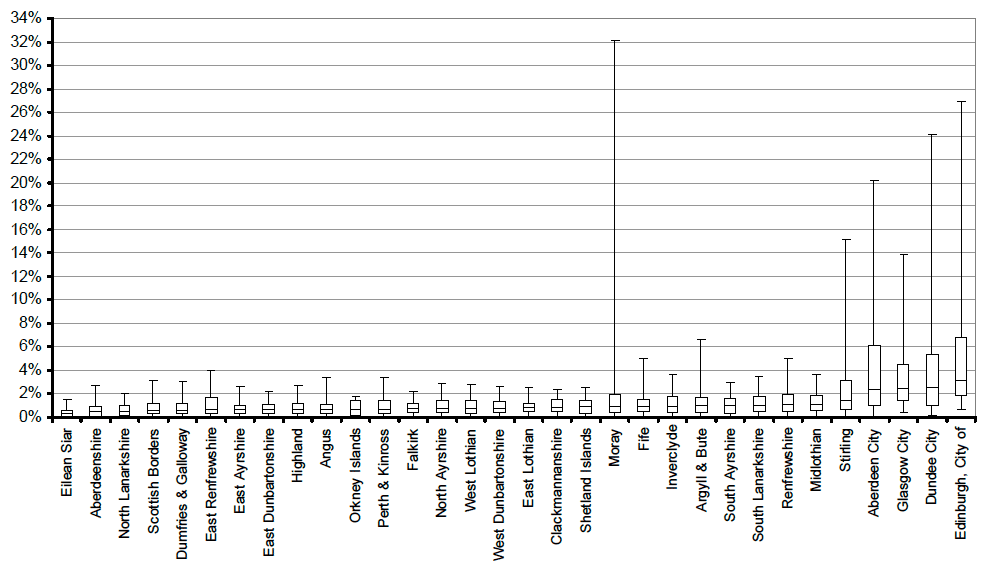
2.5 Changes in household size and type
Table 11 and Figure 18 show information on changes in household size and type, taken from the Scottish Household Survey. They show the following:
The average household size is getting smaller, with more people living alone or in smaller households.
Between 2005 and 2010, the number of households containing just one adult has increased by five per cent and the number of two adult households also increased by eight per cent.
There has been a decrease in the number of households containing one adult with children since 2005 (a fall of 11 per cent).
There has been a decline in the number of households containing two or more adults with children since 2005 (a fall of three per cent) and an increase in the number of households containing three or more adults (a rise of 11 per cent).
The changes in household composition have contributed to a four per cent increase in the number of households in Scotland between 2005 and 2010. This is higher than the increase in the population over this time (2.5 per cent) (Footnote 14).
Figure 18: Change in household type, 1981-2010 (Chart)
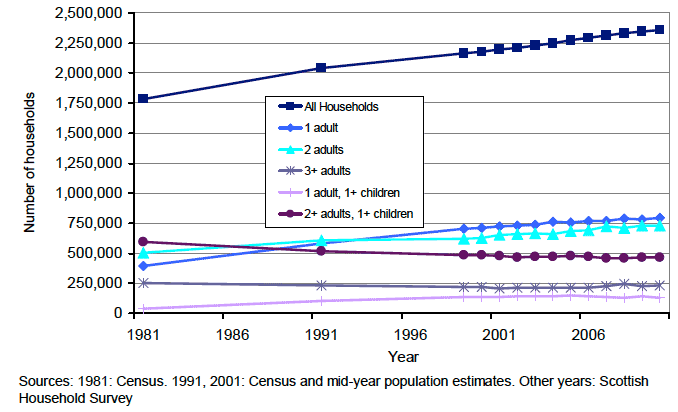
previous | contents | next



















